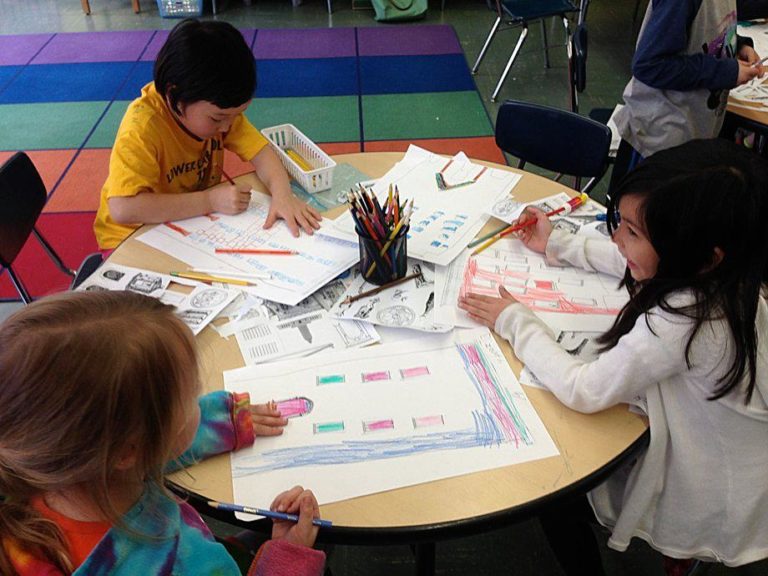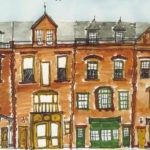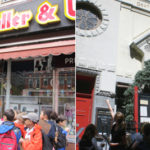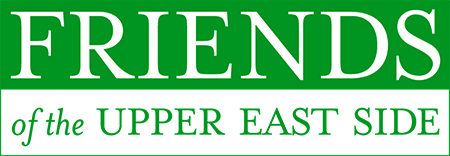Education
School Programs
Our architectural education outreach began in 1995 with our Building Fun program. Children are taught how to “read” a building. Our young architects learn about materials, architectural elements, and the history of their school neighborhood. In our Landmarks & Preservation program, they study local landmarks and historic districts as they discover the story of preservation in New York City. During our Yorkville Immigration program, they learn about the architectural history of this important Upper East Side neighborhood. Our Building Fun Basics program allows young learners to explore the concept of architecture. We are also happy to customize our classes when possible.
We offer our programs to schools located in Midtown East, the Upper East Side, East Harlem – and in other neighborhoods upon request. We currently reach over 2,000 students each school year and are proud that our programs continue to grow.

Our School Partners
We teach at many public schools, including Hunter College Elementary School, P.S. 77, 83, 87, 102, 158, 267, 290, and at private schools such as Allen-Stevenson, Brearley, Buckley, Chapin, Convent of the Sacred Heart, Dalton, East Harlem School, Hewitt, Nightingale-Bamford, Our Lady Queen of Angels, Saint Stephen of Hungary, and Spence.
Try Learning with Us
During the school year, we offer any one of our programs at no cost to schools trying that program for the first time: Building Fun, Landmarks & Preservation, Yorkville Immigration, or Building Fun Basics.
Building Fun

Can a building talk? This program awakens children’s interest in architecture and New York City history.
Recommended for 2nd-4th grades (all year), and 1st grade (spring semester)We introduce students to the idea that buildings do talk, telling us their use, material, age, and purpose. Students study historic neighborhood photographs & maps, learn 13 architectural vocabulary words, perform a block survey and play detective during a walking tour tailored to their school’s neighborhood, and act as architects as they design their own buildings, making creative decisions about the building’s use, material and architectural elements. The program is a great addition to the study of New York City, the neighborhood/community, as well as the study of history or the visual arts.
The Language of Buildings
classroom session
Students are first introduced to the notion that buildings can “talk,” i.e., convey information about themselves. Students study photographs of a variety of Upper East Side buildings to glean information about them. Visual clues and an illustrated architectural vocabulary sheet enable students to discuss the approximate age of a building, its material and use.
Walking Tour
in your school neighborhood
Armed with their new architectural vocabulary, the class embarks on a custom designed walking tour near their school to act as architectural detectives and survey the block. As the class walks, our educator encourages the students to look for visual clues that help to tell the story of the building, block and neighborhood. The history of both New York City and the local neighborhood is also explored through maps, historic photographs, outdoor clues, and students’ observations.
Art Activity
classroom session
Now that students are experts on architecture and have observed it in the field, they are ready to become “architects!” Students design their own New York City building by using drawings of architectural elements to compose a collage. From apartment buildings, museums and schools to places of worship and storefronts, the possibilities for creative designs are endless! To further reinforce the program’s concepts, each student is given a copy of our newly revamped activity booklet entitled Building Fun: Exploring Architecture with Friends of the Upper East Side Historic Districts.
BONUS SESSION
Add a Bonus Session to our programs with an exciting visit to the Museum of the City of New York! The Grid Program: Urban Planning in New York City Building upon your sessions with FRIENDS, the Grid program will reinforce architectural concepts and explore how city planning—including zoning and land use—impacts the makeup of our city’s neighborhoods. Students will learn about the origins and evolution of Manhattan’s grid system and how it has changed over time. Afterwards, the group will construct a model neighborhood that is based on community needs and conforms to this 200-year-old plan. 90 minute session- $125 HOW DOES IT WORK? 1. Schedule your program session dates with FRIENDS. 2. Contact the museum directly to add this bonus session. If possible, it is best to schedule directly after your visits with FRIENDS. Be sure to mention that you are working with us when you contact MCNY. Museum of the City of New York, 1220 Fifth Avenue (at 103rd Street) Call: 212-534-1672, ext. 3334 Email: schoolprograms@mcny.org
Building Fun BASICS
One session, designed for Preschool and Kindergarten Students
Building Fun Basics aims to introduce young children to the art of looking and understanding the built environment. The one-hour session begins with a classroom activity. We will bring in samples of real building materials to teach students about their texture, color, shape, and size. Next we will venture outside to see if students can be detectives and identify these materials and concepts in the real buildings of the neighborhood around them. Please contact Heidi Carey, Director of Education, to schedule this program: hcarey@friends-ues.org or 212-535-2526.
Explore the rich history of immigration on the Upper East Side
Recommended for 3rd-5th grades (all year) and 2nd grade (spring semester)This program explores the rich history of immigration on the Upper East Side by focusing on the German and Hungarian areas in historic Yorkville and how the built environment can provide clues to this rich heritage. Students study historic photographs, maps, learn new architectural vocabulary words, act as detectives during a walking tour, and role play as new immigrants during an art and writing activity.
Introduction to Immigration
This image filled session begins with a brief history of immigration in New York City (with a focus on the Upper East Side) in the late 19th and early 20th centuries, from the journey by ship to New York City, to the inspection stations at Ellis Island, and the choice of which neighborhood to live in. We focus on the idea of immigrant communities, including how food, music, language, and religion often made immigrants feel at home in Yorkville. Students study tenement floor plans and imagine what life was like in a tenement building. Through the study of photographs, maps and a vocabulary sheet with architectural terms, students learn how immigration affected the character of a neighborhood and its built environment.
Yorkville Walking Tour
We meet in historic Yorkville (85th Street and 1st Avenue) and embark on a walking tour of significant homes, tenement buildings, churches, and stores that reflect the historic presence of German and Hungarian immigrants. From an 1830 farmhouse to the old site of Jacob Ruppert’s brewery, students will act as detectives to discover evidence of the immigrant community and consider how food, music, language, and religion brought them together. The walk brings the study of immigration in New York City directly into their school neighborhood and show students how immigrant history can be found in their immediate built environment.
Please note:
That the walking tour for the Immigration Unit takes place in Yorkville and your educator will meet you on the southeast corner of 85th Street and 1st Avenue. Please allow time to walk there from your school.
Art Activity
The culminating lesson is an art and writing project that allows students to travel back in time to 1904 and place themselves in the shoes of a new immigrant arriving at Ellis Island and settling into the neighborhood of Yorkville. On this journey, activities include creating their own German or Hungarian passport, passing “inspection” at Ellis Island, designing a postcard with an image of their new neighborhood and writing a letter to a friend or family member in their homeland. At the end of this session, each student is given a copy of our new Yorkville Immigration activity booklet.
Yorkville Immigration

Landmarks & Preservation
Dive deeper into the NYC landmarks process
Recommended for 2nd-6th gradesCreated as a response to teachers’ requests for more in-depth landmarks information, this program offers a detailed study of landmarks, the six Upper East Side historic districts, and the history of preservation in New York City. Why are landmarks important? What does it mean to be a building in an historic district? To bring the concepts to life, the program includes a mock proposal to alter a neighborhood building, a mock Landmarks Preservation Commission Hearing, and a walking tour to view landmarks and historic districts.
Please note:
This program is wonderful in conjunction with our Building Fun or Yorkville Immigration programs and can provide students with an in depth look at landmarks, preservation, and historic districts, which are briefly touched on in Building Fun. Lesson One of this unit can also be added as a bonus session to any of our other programs.
Intro to Landmarks and Preservation
This lively classroom session begins with the story of the destruction of the original Penn Station in 1963, which sparked outrage among New Yorkers and encouraged the adoption of a Landmarks Law in 1965. The lesson culminates with a hypothetical application to alter a landmarked neighborhood building, resulting in a mock Landmarks Preservation Commission hearing and debate. Along the way we discuss how buildings make our city unique, and how students might feel if their favorite New York City buildings were torn down. If your school building is a landmark, we will explore what makes it unique, as well as study photographs and maps to learn how Landmarks are protected today through historic districts, local laws, and neighborhood preservation groups like FRIENDS!
Walking Tour
We embark on a walking tour in your school neighborhood to discover local landmarks and historic districts, paying close attention to what makes particular buildings or areas feel different and special. Are there any differences between the buildings that are in an historic district vs. those that are not? What color are the street signs in an historic district? Do we spot any plaques or clues that can help tell the story of the landmark? Can we see any construction projects or renovations taking place? We will discover answers to these questions and more as we act as landmark detectives.
The Grid Program: Urban Planning in New York City
Add a Bonus Session to our programs with an exciting visit to the Museum of the City of New York! Building upon your sessions with FRIENDS, the "Grid" program will reinforce architectural concepts and explore how city planning—including zoning and land use—impacts the makeup of our city’s neighborhoods. Students will learn about the origins and evolution of Manhattan’s grid system and how it has changed over time. Afterwards, the group will construct a model neighborhood that is based on community needs and conforms to this 200-year-old plan. 90 minute session- $125
- Schedule your program session dates with FRIENDS.
- Contact the museum directly to add this bonus session. If possible, it is best to schedule directly after your visits with FRIENDS. Be sure to mention that you are working with us when you contact MCNY.
Museum of the City of New York
1220 Fifth Avenue (at 103rd Street) Call: 212-534-1672, ext. 3334 Email: schoolprograms@mcny.orgBonus Session
Teacher Testimonials
-
The program created an architectural and artistic link as students learned about local architecture and the importance of preservation.
2nd Grade Teacher -
What a wonderful resource you all are! This added depth and meaning to our study of Yorkville. The program was wonderfully managed too!
1st/2nd Grade Teacher -
Thank you for the amazing program- my class really enjoyed their time and we definitely want to participate next year. It was fabulous how your program fit into our social studies curriculum, and I wish we could add MORE sessions!
2nd Grade Teacher -
My students have been learning what it means to be a ‘city kid’. Part of this is knowing and recognizing what is around us!
2nd Grade Teacher -
Your lessons, discussions, and models were perfectly leveled to our Class I boys. It brought the neighborhood into the classroom. Our study was greatly enhanced though your guidance and wealth of information!
1st Grade Teacher -
I loved doing the scavenger hunt for architectural elements. My students have been down these blocks hundreds of times but now they see them in a whole new way.
1st Grade eacher -
Thank you for all of the wonderful experiences you’ve given to our students and teachers this year. The girls have acquired an appreciation for their immediate neighborhood because of your knowledge.
Visual Arts Coordinator -
I loved the program, especially the building of students’ vocabulary and the application of it to the real world!
3rd Grade Teacher -
Being able to take a walking tour of the neighborhood really brought history to life and made it real for my students. They could see the real places immigrants lived and worked. (Yorkville Immigration)
4th Grade Teacher
Start learning with FRIENDS
Register your class.
Error: Contact form not found.
Education FAQs
HOW DOES IT WORK?
An experienced educator visits your classroom and brings all necessary materials. Our teachers have a strong background in arts education and love teaching your students about their amazing surroundings!
We will work to make our lessons applicable to your studies. Recent examples include incorporating Greek/Classical architecture, New York City Landmarks, geometry, and green buildings into our classes. We are one of the only programs in NYC that creates a custom walking tour for each different school that we work with.
How are sessions scheduled?
Most programs include three one-hour visits and are scheduled to be convenient for the school. It can be three consecutive Wednesdays, three days in a row, or any arrangement that is mutually agreed upon. There is also an option to combine two lessons into a longer two hour and 15 minute session. Please inquire for details. Most programs includes two classroom sessions and one walking tour.
WHAT IS THE COST?
Please contact us for program fees, as they vary based on which program you choose and the number of sessions. A reduced fee is possible in cases of documented need. Payment by check is required before the first visit.
WHAT ABOUT THE WEATHER?
We teach our programs throughout the entire school year. Please have your students dress comfortably to be outside for one hour on walking tours. If inclement weather may hamper a walking tour, our educator will be in contact with you in advance to make an educated decision and potentially reschedule.
CAN PARENTS JOIN THE WALKING TOUR?
This is up to the school and their policies, but we do require 1 adult for every 10 children on the walk. Typically we have about 3-4 parent chaperones, which can be a big help on our busy NYC streets!

